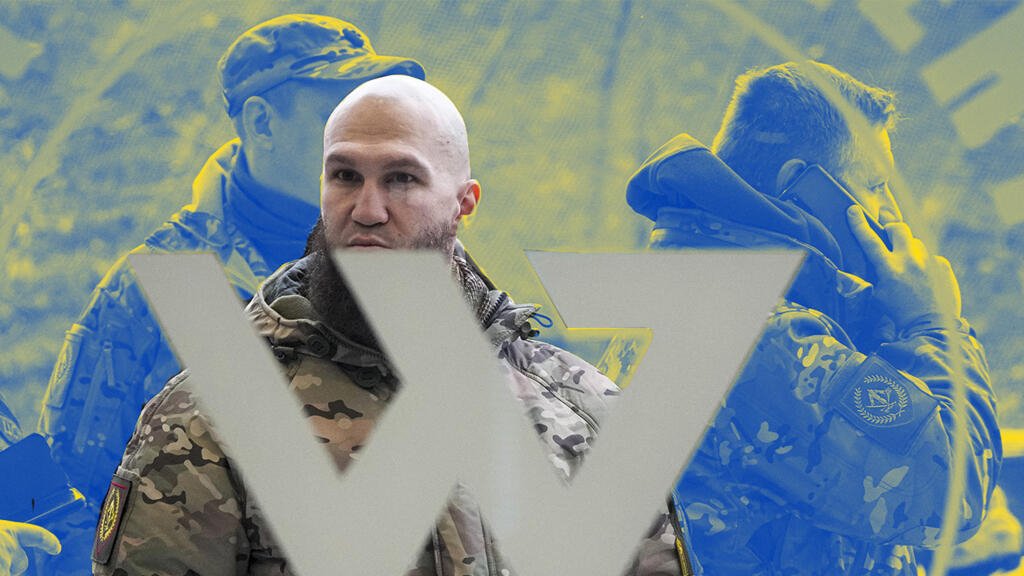Sent to kyiv at the beginning of the conflict to assassinate President Zelensky, the Wagner Group was to be Russia’s secret weapon in the blitzkrieg it wanted to wage against Ukraine. Far from this image of an elite unit, the private militia today is essentially made up of convicts who have been used as “cannon fodder” for many.
It was through a note from its secret services that the Ukrainian government discovered the Russian plan to take kyiv. On February 27, 2022, four days after the start of the Russian invasion, Ukraine reported the presence of 400 Wagner group mercenaries around the capital. His target: President Volodimir Zelensky, but also members of his cabinet. On his list were 23 names, including the mayor of kyiv, Vitali Klitschko.
“Mercenaries were very dangerous at the time. They were experienced, well equipped and trained, with several missions behind them in Syria, Mali and other places,” explains Karen Philippa Larsen, a security expert at the Danish Institute for International Research (DIIS). ), specialized in the study of the Wagner Group.
Founded in 2014, the Wagner Group made headlines that same year during the first fighting in the Donbass region of Ukraine and in the context of Moscow’s annexation of the Crimean peninsula.
Little by little, the organization extended its activities to around thirty countries, in particular Syria, Libya, the Central African Republic and Mali.
Known for its brutality, the militia operates underground, allowing Moscow to deny its official involvement in armed conflicts, while also serving as an instrument of geopolitical influence.
Terror in Bucha
Although the group maintained its presence in Ukraine after 2014, the Russian invasion led to a massive arrival of its mercenaries. According to Ukrainian intelligence services, between 2,000 and 3,000 soldiers recruited by Wagner entered the country in January 2022, just weeks before the invasion began on February 24.
“Already in December 2021, we found out that Wagner had launched a new recruitment campaign. At that time, it was not known for what purpose until the invasion began,” recalls Karen Philippa Larsen.
After learning of the presence of the mercenaries in kyiv, at the beginning of the conflict, the Ukrainian government immediately decided to impose a 36-hour curfew and strict confinement of the population. Anyone who ventured outside their homes could be suspected of being a Russian agent and face arrest.
Controlled by Ukrainian security forces, Wagner joined the Russian Army in fighting near the capital.
His mercenaries appeared mainly in the spring in Bucha, a city that was touched by fierce fighting, located 25 km northwest of the capital. It was also the scene of alleged war crimes committed against civilians.
After the Russian withdrawal, the first images of streets full of corpses of their inhabitants began to go around the world. Some have their hands tied behind their backs. Others were mutilated or burned.
According to local authorities, during the Russian occupation, 419 people died, including nine children. There were also numerous reports of alleged torture and rape.
Although Russian troops played an important role in these abuses, members of the Wagner group also participated in this terror strategy, according to German intelligence services.
Less trained, less equipped
The summer of 2022 was a turning point in the involvement of the Wagner Group in Ukraine. Instead of recruiting professional military personnel, Vladimir Putin’s shadow army began recruiting from Russian prisons.
In a video posted on ‘Telegram’, Wagner’s boss, Yevgeny Prigozhin -nicknamed “Putin’s cook”- promises the prisoners amnesty in exchange for a six-month commitment to his offensive in Ukraine.
“It has been a huge change that has transformed the nature of the group,” analyzes Karen Philippa Larsen, recalling that of the 50,000 mercenaries deployed in Ukraine, 40,000 are Russian prisoners.
“Unlike the original members of Wagner, these detainees were only trained for a few weeks. Just long enough to become familiar with the use of a weapon. They are also much worse equipped,” adds the researcher.
Scorned by the most experienced mercenaries, these prisoners are sent to the most dangerous places on the front lines, explains Karen Philippa Larsen, especially in the east, in Bakhmut, described as a “butcher shop” by Evgeny Prigojin. “We send them to find out where the Ukrainians are shooting from. For Wagner, they use them as ‘cannon fodder.'”
This year also marked the formalization of Wagner’s existence. Prigozhin, who had long denied his ties to the militia, acknowledged in late September that he was the head of the paramilitary organization, before opening a headquarters in St. Petersburg in November.
A complete change of strategy aimed at establishing Prigozhin’s legitimacy and positioning him on the Russian political scene through the image of a dynamic warlord, according to Karen Philippa Larsen.
While the Russian Army fights in the Ukraine, Wagner claims success in the East. Currently, there is a growing rivalry between the militia and the Ministry of Defense: Prigozhin is increasingly open about the “incompetence” of the Moscow forces.
The growing rivalry
However, Wagner paid dearly for his “successes” at the front. Philippa Larsen estimates that 40,000 mercenaries, or 80% of the force, have deserted, surrendered, been killed or wounded. “There are only 10,000 fighters left in Ukraine,” adds the researcher, pointing out that these casualties are not counted by Moscow because these soldiers do not belong to the regular army.
In recent months, various testimonies and videos have demonstrated the brutality of the group’s internal operations. In November, Yevgeny Prigozhin coolly commented on the video of the execution of a “deserter” with a hammer: “A dog deserves a dog’s death.”
During the months of December and January, the Wagner Group reportedly lost most of its forces in the Battle of Soledar, carrying out desperate waves of assaults against the Ukrainian defenders. “It was a suicide mission,” says Karen Philippa Larsen, who believes the takeover of the city was due more to the staggering number of soldiers sent to their deaths than any military strategy.
Wagner claimed responsibility for Soledar’s capture on January 11. But the announcement was not confirmed by Moscow. The next day, the Russian Defense Ministry claimed that the city had fallen, but made no mention of the contribution of Wagner’s mercenaries. Furious, Prigozhin accused the Russian Army of having “stolen victory” from his men.
Since then, relations between Prigozhin and the General Staff, already appalling, have continued to deteriorate.
In February, Wagner announced the end of his prisoner recruitment drive, despite heavy casualties. According to Karen Philippa Larsen, this decision was likely the result of a direct order from the Russian Defense Ministry, which remains Wagner’s main supplier and therefore has the power to cut off funding for him.
“Russian law has also been changed to allow the group to recruit people with criminal records,” the expert says. It is a way for the Russian Army to partially free itself from its dependence on the infantry supplied by Wagner.
This rivalry recently reached a new level when Prigozhin criticized in mid-February the chief of the General Staff, Valeri Guerassimov, and the Defense Minister, Sergei Shoigu, for the lack of material support for members of his militia. According to him, a form of “treason.”
Wagner now seems a long way from the image of a group of hardened soldiers, observes Karen Philippa Larsen, who sees Prigozhin increasingly marginalized by Moscow.
“However, don’t underestimate him. You now have two options: either leave the Ukraine and focus on building an army of professionals operating abroad, or insist on staying in Ukraine. But this scenario will largely depend on your ability to recruit new fighters, something that is becoming more and more difficult for him.
This text has been adapted from its original French version.













